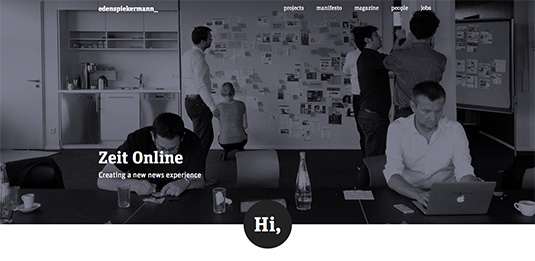The art of being agile in an agency
The co-owner of Edenspiekermann reveals how they inspect and adapt their workflows.

You've all heard about agile methods like scrum and Kanban. They have proven to be successful ways to build website templates and manage software. But are agile approaches also compatible with the project-based business model of an agency? Is it possible – or even advisable – to use a method that keeps your client in the dark about what they will get in the end?
Welcome to Edenspiekermann, a global agency that shapes brands by creating digital products, services and experiences. We are around 100 people from over 16 nations working in five offices worldwide. With backgrounds in graphic design, corporate design and typography, we have gone through an interesting transformation over the past six years.
The world has changed and the design business has changed. We are now deeply involved with digital product development and employ about as many developers as we do designers.
Complicated vs complex
In 2009, we learned (the hard way) that the waterfall process of sequential design does not work well with digital projects. So we taught ourselves new, agile approaches and got an experienced 'scrum master' on board. The results were terrific and we never looked back [for an introduction to the agile approach, see netm.ag/agile-278].
Using agile methods led us to adopt agile mindsets. This was more than a change of method, it was a change in our company culture and our client relationships. The iterative and user-centric nature of agile techniques helps us create beautiful, useful digital products.
We describe tasks in 'user stories' and base every decision regarding design or technology on researched user needs. As a result, we are sure to create stuff that is relevant and of value to the user.

Still, I have to admit that we're far from smooth sailing. We found agile methods easy to learn, but hard to implement in our organisation. Learning new processes, methods and techniques was not enough. We had to adopt a new mindset, acknowledging that planning involves guesswork, and control must be replaced by trust.
Daily design news, reviews, how-tos and more, as picked by the editors.
As a multidisciplinary team, it was especially important that we learned to see digital product development as a process that isn't complicated (like a machine), but complex (like a football game). It can't be controlled or predicted. It can only evolve in a way that allows for constant adaptation, learning and change.
Agile management
In my experience, this paradigm shift is often too challenging to accept. If the agency management or the decision-makers on the client side can't commit to this new way of thinking, the project is doomed. I've seen many projects fail, not because the team couldn't be agile, but because the environment wasn't ready for that agility.
Let me remind you of the three roles in a scrum. First, there's the product owner. He acts like a CEO for the project, representing the interests of the end users and ranking tasks according to their business value. Then there's the scrum master who, like a referee, moderates the process without influencing it. Finally, there's the team, which manages itself.
Wait, what? The team manages itself? That's correct. If you can't accept this, you will only be frustrated by agile methods. An agency with an agile-minded management is halfway there. But only the agency that can educate its clients, and build trusting relationships through agility will be truly successful.
We have to let go of our old methods and mindsets. We have to create an atmosphere of transparency. So to the bosses, managers, and anyone else calling the shots, I would say this: open yourselves to change.
Push yourselves out of your comfort zones. Admit that Gantt charts are pure science fiction. If you let go of your notions of control and create an atmosphere of trust, great things are sure to happen.
And don't think you've nailed it. Ever. In our modern working environment, a winning strategy means being open to constant change. The journey never ends. And I think that's great.
This article was originally published in net magazine issue 278.
